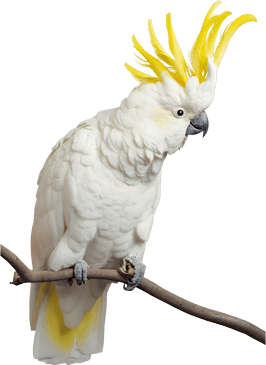Profiles
SULPHUR CRESTED COCKATOO
(CacatuaGalerita)
Family: Parrot
Origin: Widely distributed in most timbered country throughout northern, eastern and south eastern Australia. Also found in Tasmania, Kangaroo Island, Papua New Guinea and Indonesia.
Size: Length is 490mm including 210mm tail.
Description:
The male and female adult birds are similar to look at. The feathers are white with a narrow forward yellow crest, the ear coverts and base of the cheek and throat have yellow feathers. Undersides of flight and tail feathers are washed with yellow. It has brown eyes, a grey-black beak and dark grey legs. The immature birds are also similar looking.
Care:
Cockatoos are destructive birds and need to be housed in large, strong cages, or aviaries made with metal frames (2.5cm x 1.25cm netting recommended) to form a flight.
They will also need a sheltered area within the aviary especially during storms. Strong branches from non poisonous trees may be used for perches (your nurseryman or vet may be able to advise you). And if you’re building an aviary you will need to check with your local council for they have by-laws in place governing the size.
Cockatoos can be trained to move around the house by tethering them to a moveable cocky stand. In the wild they nest in hollow tree trunks and branches and if you can get your hands on some of these they can also be used in your aviary.
The female usually only lays two eggs and the incubation period is 30 days with both sexes taking it in turn to “sit” on the eggs. Once hatched, the chicks remain in the nest for six weeks at which time they are mature enough to fly off and fend for themselves.
Seed dishes and drink vessels must be cleaned regularly. Only mild soaps should be used and then it must be rinsed off thoroughly. Never use any cleaning detergents or chemicals because birds have very sensitive systems.
Cuttlefish bone and shell grit needs to be available at all times, and fresh water must be given daily along with fresh seed and greens. Vents need to be checked to ensure they are clean, and any food stuck in beaks of growing chicks must be removed to prevent any misshapen beaks from forming.
Eats:
Fresh, good quality large parrot mix consisting of oats, wheat, sunflower, almond, walnuts, peanuts, most types of green vegetables such as spinach or silver beet, broccoli, corn on the cob, carrots, apples, oranges and most fruits except avocado which is poisonous to birds. For a treat, they love a biscuit.
Features:
In the wild, cockatoos usually feed on seed during the morning and in the afternoon and hotter part of the day just rest up in the trees near their feeding ground, and then at dusk fly off to their roosting trees.
In the wild they eat grass seeds and herbaceous plants, grain, bulbous roots berries and nuts, insects and their larvae. And because they often travel in large flocks they are a menace to farmers and cause a lot of damage to their crops such as wheat, oats and corn.
Call:
An extremely noisy call which is a harsh screech ending with an upward inflection and if it’s alarmed it will invoke a succession of abrupt guttural screeches. When feeding, or preening, they have an occasional squawk or a two syllable whistle.
Personality:
Cockatoos love to be handled by their owners and enjoy human company, but owners and visitors alike always need to exercise caution when handling this bird because its powerful beak can cause serious injury if it decides to bite. They can be trained to talk and can live up to 100 years of age.
